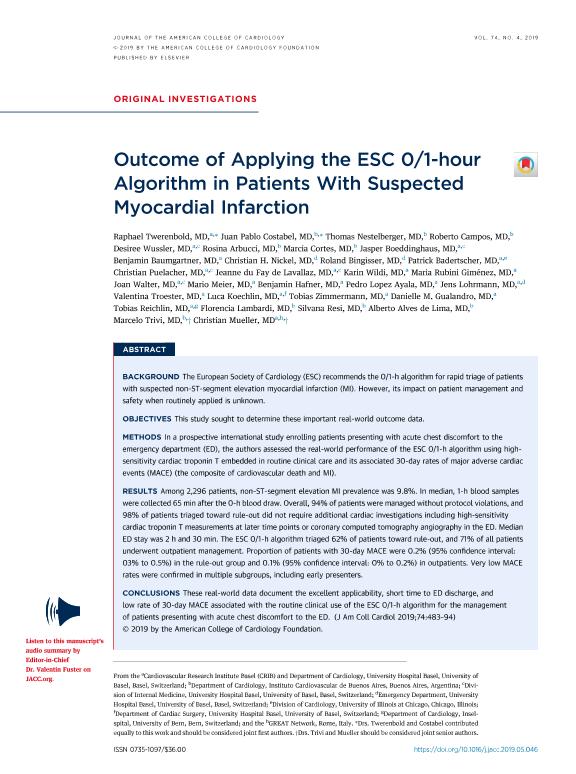Artículo
Outcome of Applying the ESC 0/1-hour Algorithm in Patients With Suspected Myocardial Infarction
Twerenbold, Raphael; Costabel, Juan Pablo; Nestelberger, Thomas; Campos, Roberto; Wussler, Desiree; Arbucci, Rosina; Cortes, Marcia; Boeddinghaus, Jasper; Baumgartner, Benjamin; Nickel, Christian H.; Bingisser, Roland; Badertscher, Patrick; Puelacher, Christian; du Fay de Lavallaz, Jeanne; Wildi, Karin; Rubini Giménez, Maria; Walter, Joan; Meier, Mario; Hafner, Benjamin; Lopez Ayala, Pedro; Lohrmann, Jens; Troester, Valentina; Koechlin, Luca; Zimmermann, Tobias; Gualandro, Danielle M.; Reichlin, Tobias; Lambardi, Florencia; Resi, Silvana; Alves de Lima, Alberto Enrique ; Trivi, Marcelo Ricardo; Mueller, Christian
; Trivi, Marcelo Ricardo; Mueller, Christian
 ; Trivi, Marcelo Ricardo; Mueller, Christian
; Trivi, Marcelo Ricardo; Mueller, Christian
Fecha de publicación:
30/07/2019
Editorial:
Elsevier
Revista:
Journal of the American College of Cardiology
ISSN:
0735-1097
Idioma:
Inglés
Tipo de recurso:
Artículo publicado
Clasificación temática:
Resumen
Background: The European Society of Cardiology (ESC) recommends the 0/1-h algorithm for rapid triage of patients with suspected non–ST-segment elevation myocardial infarction (MI). However, its impact on patient management and safety when routinely applied is unknown. Objectives: This study sought to determine these important real-world outcome data. Methods: In a prospective international study enrolling patients presenting with acute chest discomfort to the emergency department (ED), the authors assessed the real-world performance of the ESC 0/1-h algorithm using high-sensitivity cardiac troponin T embedded in routine clinical care and its associated 30-day rates of major adverse cardiac events (MACE) (the composite of cardiovascular death and MI). Results: Among 2,296 patients, non–ST-segment elevation MI prevalence was 9.8%. In median, 1-h blood samples were collected 65 min after the 0-h blood draw. Overall, 94% of patients were managed without protocol violations, and 98% of patients triaged toward rule-out did not require additional cardiac investigations including high-sensitivity cardiac troponin T measurements at later time points or coronary computed tomography angiography in the ED. Median ED stay was 2 h and 30 min. The ESC 0/1-h algorithm triaged 62% of patients toward rule-out, and 71% of all patients underwent outpatient management. Proportion of patients with 30-day MACE were 0.2% (95% confidence interval: 03% to 0.5%) in the rule-out group and 0.1% (95% confidence interval: 0% to 0.2%) in outpatients. Very low MACE rates were confirmed in multiple subgroups, including early presenters. Conclusions: These real-world data document the excellent applicability, short time to ED discharge, and low rate of 30-day MACE associated with the routine clinical use of the ESC 0/1-h algorithm for the management of patients presenting with acute chest discomfort to the ED.
Archivos asociados
Licencia
Identificadores
Colecciones
Articulos(SEDE CENTRAL)
Articulos de SEDE CENTRAL
Articulos de SEDE CENTRAL
Citación
Twerenbold, Raphael; Costabel, Juan Pablo; Nestelberger, Thomas; Campos, Roberto; Wussler, Desiree; et al.; Outcome of Applying the ESC 0/1-hour Algorithm in Patients With Suspected Myocardial Infarction; Elsevier; Journal of the American College of Cardiology; 74; 4; 30-7-2019; 483-494
Compartir
Altmétricas



